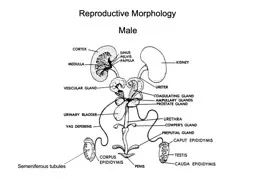

Semeniferous tubules Reproductive Morphology Male Position of testes varies May remain in abdominal cavity permanently Monotremes Xenarthrans amp most marine mammals May reside in abdominal cavity but descend into scrotum during breeding season ID: 816321
Download The PPT/PDF document "Reproductive Morphology Male" is the property of its rightful owner. Permission is granted to download and print the materials on this web site for personal, non-commercial use only, and to display it on your personal computer provided you do not modify the materials and that you retain all copyright notices contained in the materials. By downloading content from our website, you accept the terms of this agreement.
Slide1
Reproductive Morphology
Male
Semeniferous tubules
Slide2Reproductive Morphology
Male
Position of testes varies:
May remain in abdominal cavity permanently (Monotremes, Xenarthrans, &
most marine mammals)
May reside in abdominal cavity but descend into scrotum during breeding season
through inguinal canal (bats and rodents)
May be permanently housed in scrotum (most primates and terrestrial carnivorans)
Many marsupials have a bifurcate penis:
Slide3Variation in Bacula
Chipmunks
Ground squirrels
Slide4Reproductive Morphology
Female
Marsupials
Slide5Reproductive Cycles
Almost all mammals are iteroparous - >1 cycle per lifetime
A few insectivorous marsupials are semelparous – 1 cycle per lifetime
Antechinus
- Males all die after a single frantic bout of reproduction.
This is driven by extreme sperm competition.
Fisher et al., 2013. Sperm competition drives the evolution of suicidal
reproduction in mammals. PNAS 110:17910-1791
Slide6Reproductive Cycles
Ovarian Cycle
Uterine Cycle
Estrous Cycle
Slide7Spermatogenic Cycle
Slide8Control of Cyclicity
Primarily, all cycles are under control of pituitary hormones.
Many cues that induce the pituitary to initiate cycles.
Visual Cues - In some mammals, the sight of scrotal testicles actually
induces female estrous cycle.
L'Hoest's
monkey
Cercopithecus
lhoesti
Slide92. Behavioral Cues may trigger hormonal responses.
Control of Cyclicity
suckling – macropodids
copulation in felids
Slide10Microtus montanus
Dipodomys ingens
Control of Cyclicity
3. Environmental cues operate external to cycles may confer seasonality.
Slide11Mechanisms for Optimizing Timing of Birth
Artibeus lituratus
(Big fruit-eating bat)
2) Delayed development
Myotis
ciliolabrum
(Western small-footed
myotis
)
1) Delayed fertilization
Slide123) Delayed implantation
(Chiroptera, Carnivora, Xenarthra, Cetartiodactyla)
Zona Pellucida
Mechanisms for Optimizing Timing of Birth
Obligate
Ursus americanus
Facultative
Many Rodents
Slide133) Delayed implantation
(Chiroptera, Carnivora, Xenarthra, Cetartiodactyla)
Mechanisms for Optimizing Timing of Birth
Well-studied in Mustelidae
(Thom et al. 2004. Evolution 58:175)
Mustela erminea
Slide144) Embryonic diapause
(Macropodids)
Mechanisms for Optimizing Timing of Birth
Slide15General Trends Relating to Body Size
1. Total number of offspring per lifetime decreases with increasing body size
Peromyscus maniculatus
P. truei
P. californicus
Slide16General Trends Relating to Body Size
2. Small mammals tend to have higher basal metabolic rates
a. Large litters
b. Short gestation times
c. Altricial young
d. High post-natal growth rate
e. Reach reproductive age very quickly
Slide17General Trends Relating to Body Size
3. Large mammals tend to have lower BMR and tend to have much longer lives.
a. Long estrous cycles.
b. Small litter size.
c. Precocial young.
d. Grow much more slowly.
Slide18Exceptions to Body Size/Reproduction Trends
1) Microchiroptera
- only 1 or 2 young annually.
- low metabolic rates for their size
- first reproduction is at 18 months
- very long life spans.
Slide19Exceptions to Body Size/Reproduction Trends
2) Macroscelidids
Elephantulus
- Small litters : 1-2
- Precocial young
- Long gestation (~ 60 days)
Slide20Exceptions to Body Size/Reproduction Trends
3) Hystricognaths
Tuco-tuco
,
Ctenomys sociabilis
- Large/small trends break down in this group.
- In general, hystricognaths have longer gestation time than sciurognaths.
Slide21Exceptions to Body Size/Reproduction Trends
4) Marine carnivores (Pinnipeds)
Mirounga
- have incredibly rapid post-natal growth rates